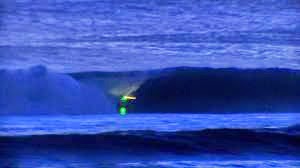Red tide sweeps through southern California, an algae
bloom spreading phosphorescent phytoplankton up and down the coast. The bioluminescence does play a role in the food chain—it’s a
defense mechanism. Apparently the glow not only deters natural grazers of these
dinoflagellates, but also attracts those organism’s predators, who, like us,
are attracted to the light. The scientists say it isn’t harmful, contrary to most rumors. Red
tide looks and smells dirty, but the bacteria level in the ocean stays roughly
the same.
Some avoid duck dives and head dips to keep their insides algae
free, others freely ingest the water, curious if it will glow on the way out
the next day. Regardless, it’s inspired many to throw their wetsuits on for
late-night sessions lit by the sparks of the algae, where every wave feels like
a science experiment.
SURFER Magazine caught up with Dr. Peter Franks of UCSD’s Scripps
Institute of Oceanography for more information and to double check that we
won’t get sick:
Many are claiming this as one of the heaviest
red tides in decades. What’s your theory on the cause of such a strong bloom in
the area?
The organisms that form this red tide are phytoplankton—tiny
single-celled plants. Like terrestrial plants they require light and nutrients
to grow. It is likely that this red tide was preceded by some sort of injection
of nutrients into the upper layer of the ocean. This could have happened
through an uplifting of the deep, nutrient-rich waters by a variety of physical
forces. Some of these forces are local (enhanced mixing) and some are remote
(winds off Baja). At this point we don’t have any conclusive evidence to
support any particular mechanism as being responsible for the red tides we get
in Southern California. It is likely a very complicated combination of physics,
chemistry and biology. We have been getting red tides in this region since
before recorded history—they are natural phenomena—but they are very difficult
to sample because they are so unpredictable.
How long do you think it will last?
The organisms forming this red tide are very sensitive to
turbulence. So if we get a particularly windy day, the red tide might disappear
in a day or two. The red tide-organisms are also being eaten by other
organisms, and killed by bacteria. Once the mortality becomes higher than their
growth rate, the red tide will disappear. It could be gone in a day, or it
could last a month or more. It is as unpredictable as the weather.
How would you explain to a surfer that red tide
won’t kill them? That’s true, right?
Many red tides are extremely toxic and can kill people who eat
shellfish that concentrate the toxins. This particular organism contains no
toxins that are known to affect humans. If you drink the water you’d die from
salt poisoning long before you died from phytoplankton toxins. However, the
organic material that is secreted by the red-tide organisms may help to prolong
the life of human pathogenic bacteria in the ocean, potentially increasing the
possibility of being infected by one of them. Many people have written to tell
me that they suffer an allergic reaction to red tides. I have never heard of
this being investigated carefully, and it would be worth trying to identify the
compounds that people are reacting to. They may be from the red-tide organisms,
or they may be from bacteria or other organisms that grow during a red tide.
Have you gone in the water at night yet?
I haven’t (I’ve been traveling) but I’ve heard wonderful stories
from people who have been swimming in the red tide at night. It’s seriously
spectacular! But don’t go in alone—it’s dangerous to swim alone at night.
And if the Ocean doesn't light the way for you then you still have a few options. Check out the future of night time surfing:























No comments:
Post a Comment
Note: Only a member of this blog may post a comment.